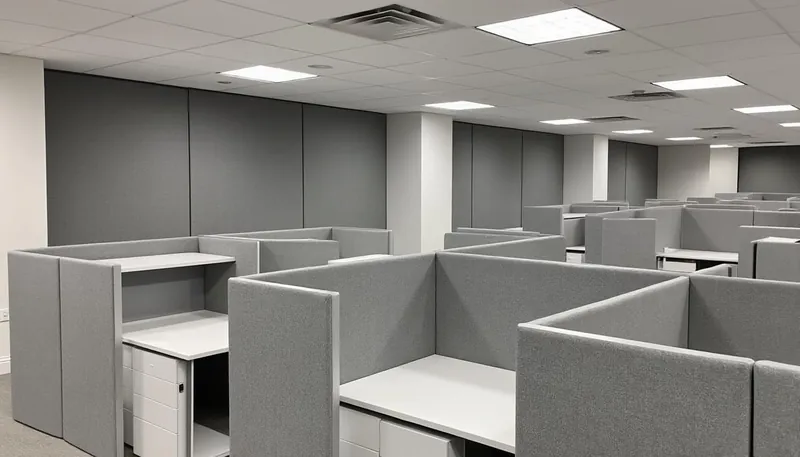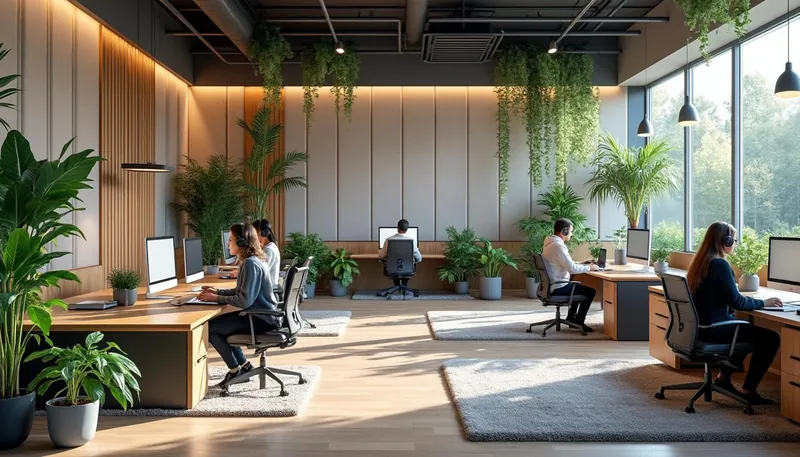In the world of work today, where open-plan offices are the norm, the clamor of active dialogues, ringing phones, and the sounds of equipment can be a double-edged sword. There’s a growing appreciation for the camaraderie fostered by such spaces, but the urgent necessity to minimize distractions and enhance productivity has never been more crucial. Countless studies have shown that excessive noise in shared workspaces significantly hampers both focus and job satisfaction. As we dive into effective noise reduction strategies for open-plan offices, think of this guide as a treasure trove of insights that lead to a quieter, more conducive work environment.
Brief
- Understanding the impact of noise on productivity.
- Identifying common sources of office noise.
- Implementing acoustic solutions like panels and furniture.
- Creating dedicated quiet zones for focused work.
- Emphasizing team etiquette to maintain a peaceful atmosphere.
The Impact of Noise on Productivity
Noise isn’t just an annoying background hum; it has a profound effect on the efficiency and well-being of employees. When people are besieged by sounds from conversations or phones ringing, it can lead to a state of constant distraction. Research shows that around 63% of office workers find their environments not conducive to focus, which means they struggle to complete tasks efficiently.
Let’s break this down further:
- Increased Stress Levels: Studies indicate that persistent noise can heighten stress levels, triggering the body’s fight or flight response. This not only affects an employee’s mood but can also lead to chronic health issues.
- Lower Job Satisfaction: Employees who feel bombarded by noise are more likely to report dissatisfaction in their jobs, which can contribute to higher turnover rates. When employees don’t feel comfortable in their environment, their loyalty to the company diminishes.
- Potential for Errors: A noisy environment can lead to increased mistakes. When distractions abound, employees take longer to complete tasks and are more susceptible to oversight.
Illustrating this loss of productivity, consider an office that houses several teams communicating simultaneously. If one team covers a product launch, while another is brainstorming ideas, it’s easy to see how sound merges and leads to confusion and decreased output. It’s imperative to recognize the urgency of addressing noise levels for the collective well-being of all members.

Identifying Common Sources of Noise in Open Offices
Before you can tackle the issue of noise, it’s essential to understand what’s causing it in the first place. In an open-plan office, sound bounces around freely, exacerbating disturbances common to shared environments.
Some prime culprits include:
- Conversations: Simple chatter can morph into a cacophony in an open area. When voices intermingle, it creates a noise floor that is difficult to ignore.
- Phone Calls: It’s not just the sound of phone rings but also the conversations that follow which contribute heavily to office noise. Employees on calls often speak louder than they realize, spiraling into disarray.
- Office Equipment: Printers, copiers, and similar devices contribute to physical noise. Their mechanical movements and alerts can be particularly intrusive.
Start by conducting a thorough sound audit of your workspace. Encourage employees to keep a record of noise levels they experience throughout the day to identify peak times and sources. Understanding the most significant contributors to noise will pave the way for informed decisions on how to mitigate them effectively.
Implementing Acoustic Solutions for a Quieter Workplace
Once you identify the main sources of noise, it’s time to integrate effective solutions. Acoustic panels are among the most successful tools available. These are specially designed to absorb sound waves, significantly reducing echo and creating a much quieter atmosphere. For example, companies like Acoustics First, Vicoustic, and Snowsound offer panels that combine aesthetic design with functionality.
Here are some practical solutions to consider:
| Solution | Description | Estimated Cost |
|---|---|---|
| Acoustic Panels | Wall and ceiling installations that absorb sound. | $50 – $250 each |
| Soundproof Partitions | Free-standing or desk-mounted partitions to create zones. | $100 – $500 each |
| Acoustic Furniture | Furniture designed to limit sound propagation. | $200 – $800 per piece |
Be sure to incorporate these solutions into your overall office design. For instance, if phone calls are a major source of interruption, consider providing booths or quiet pods designed for focused conversations. This way, employees can retreat into a designated space, minimizing disruption for others.

Creating Dedicated Quiet Zones for Focused Work
Amidst the ruckus of an open office, the creation of quiet zones is vital for employee productivity. These areas signal to employees that they can take a moment to focus without outside disturbances.
Establishing quiet zones means designating spaces where no conversations or phone calls are allowed. Making these spaces attractive and accessible will encourage usage. Here are several tips for implementing quiet zones:
- Use Soundproof Partitions: To delineate quiet spaces, set up soundproof partitions around areas designated for focusing work.
- Guidelines for Use: Establish clear rules for quiet zones, such as no phone calls and maintaining a low volume of noise. Make sure everyone is briefed on these guidelines.
- Bookable Spaces: Allow employees to reserve quiet zones for intensive tasks. This can help in managing who occupies the space and ensure its integrity as a quiet area.
The commitment to quiet zones can significantly reduce distractions and enhance employee morale. When people know they have a designated space for focus, they feel more empowered to tackle challenging tasks.
Establishing Team Etiquette for Noise Management
To foster a truly productive workspace, establishing a team culture that emphasizes quiet etiquette is a must. Everyone plays a crucial role in maintaining a harmonious atmosphere. By promoting a culture of mindfulness regarding noise control, you significantly improve the overall work environment.
Here are some etiquette tips to consider:
- Soft Voice Guidelines: Encourage team members to converse in lower tones when within earshot of their colleagues.
- Discretion During Calls: Promote the use of headsets during phone calls, allowing conversations to be more private and less distracting.
- Scheduled Collaboration: Plan collaborative meetings during less busy hours to minimize potential disruptions.
Additionally, hosting workshops that educate employees about the impact of noise can instill a mindset of awareness and respect. By continuously reinforcing these values, you foster a cooperative environment where everyone feels heard and valued.
What are effective ways to reduce noise in an open-plan office?
Some effective methods include using acoustic panels, establishing quiet zones, and promoting team etiquette around noise management.
How do noise levels affect employee productivity?
Excessive noise can lead to increased stress, lower job satisfaction, and the potential for more errors, significantly hinder productivity.
Can quiet zones really improve focus?
Yes, dedicated quiet zones provide a space where employees can work without distractions, allowing for deeper concentration and higher productivity.


